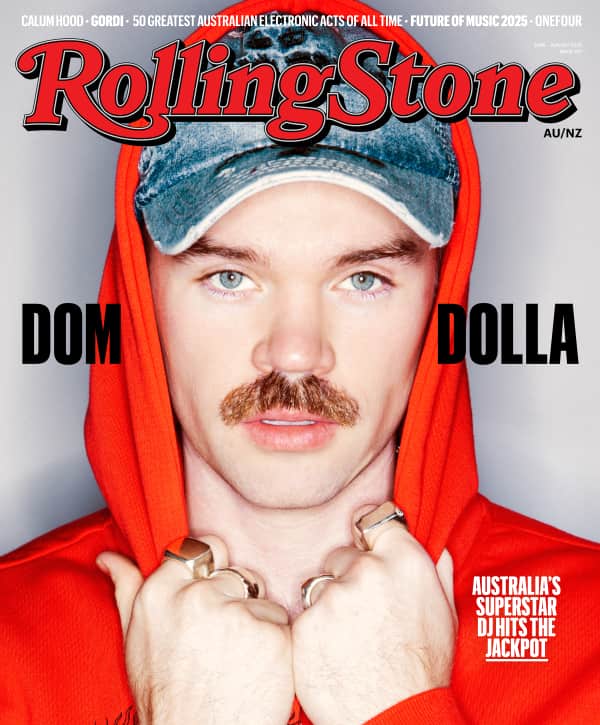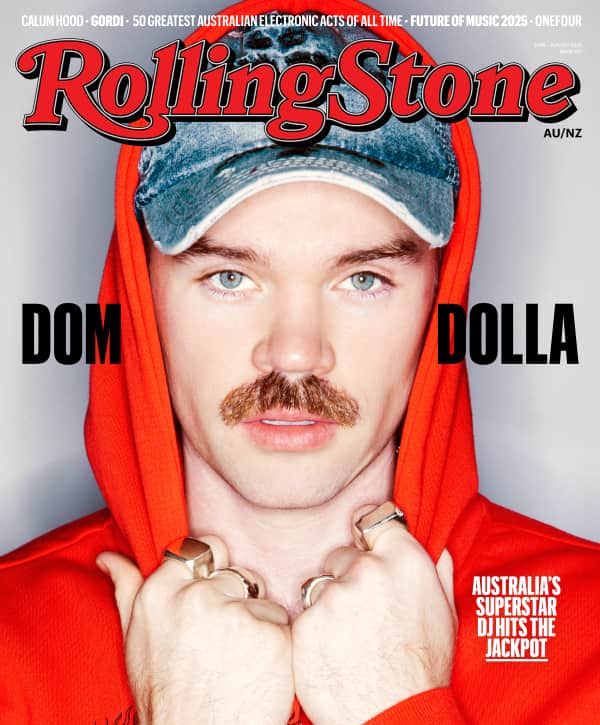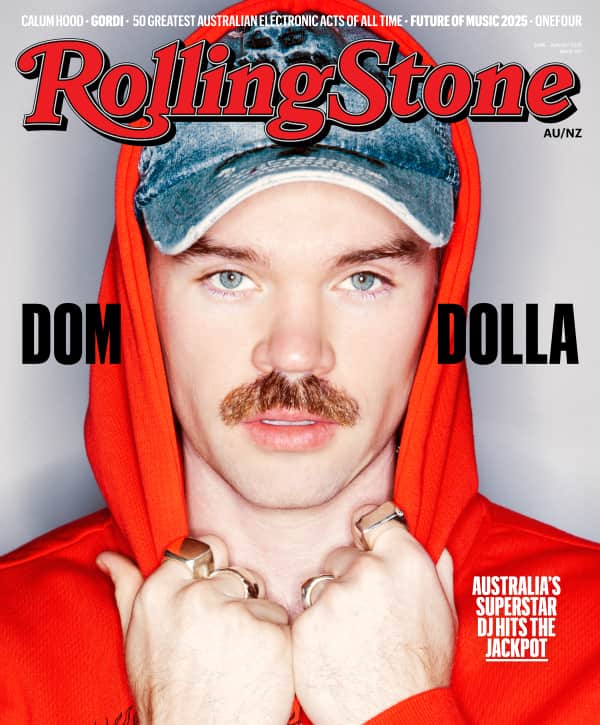One day in May 1988, Antoine Le Grand, a photographer in Paris, was sent on a mysterious assignment for a culture magazine called Globe. Two young men had called the office claiming to be the culprits in one of rock’s most legendary heists: the recent theft of a 300-pound bust of Jim Morrison from his gravesite at the Père Lachaise cemetery. They wanted notoriety — and their pictures in a magazine. Le Grand went to an address in a tony part of town near the Left Bank of the Seine, the 14th arrondissement. “The house was really nice design and made by an architect,” he recalls. “Whoever lived there, they are really rich people.”
Inside, Le Grand met the two French guys, who had short, punky dark hair. The bust sat on the floor behind them, graffitied, covered in candle wax, missing its nose, and weathered from the seven years it had served as a shrine to Morrison’s passionate, grieving fans. The thieves wouldn’t say anything about themselves. They each went by the nickname “X.” They seemed “a bit afraid,” Le Grand recalls. “They want to [take the photos] very quickly in the room, and they want to put on a mask.” They wrapped bandanas around their faces, exposing only their eyes. Le Grand had the impression the whole thing was done as “a challenge,” he says. “They were smoking weed and having fun.” He photographed them in black and white, their masked faces alongside the statue, their eyes staring intently into the lens.
In a brief video interview at the time, one of the alleged thieves appears without his mask to tell the story of what happened. He wears blue jeans, a thick black belt, and a tucked white T-shirt. His dark hair is shaved at the sides with a roosterfish coif at the top, and he wears dark round sunglasses, like an early-Eighties Dave Gahan of Depeche Mode. Another young man, presumably X2, sits in the shadows nearby. The room is collegiate, with two tall, triangular black speakers against the wall, one with a yellow motorcycle helmet stuck on top.
X1 sits on the floor in front of a Doors poster and tells their story. They’d ridden their moped to the cemetery one spring night, he says, and parked outside. Working fast, they twisted the bust off its rebar mount and lifted the statue together. Even between two of them, it weighed too much to manage. “We rolled the bust between the graves because it was too heavy to carry,” X1 goes on in French. To get it outside the cemetery without being conspicuous, they hid it inside a trash can which they carried out to their moped.
From there, X1 claims, they escaped through the Paris streets, him holding the bust between his legs as X2 drove. “It was a really messed-up plan,” he says. “Especially since we ran out of gas.” As they were filling up at a station, “the bust fell,” he recounts. “We were scared.” But they made it back to their apartment, feeling justified that they had saved the sacred landmark from the vandals at Père Lachaise. “Now it’s here,” he says. “It’s fun to listen to the Doors and see it sitting there.”
DESPITE THE TWO CLAIMING responsibility for the theft, there were never any arrests in the case. The Morrison bust remained missing, and the crime unsolved, for decades. Theories as to what happened became the stuff of urban legend and online chatter. (As with Elvis Presley’s misspelled middle name on his grave at Graceland, conspiracists took it as a sign that the troubled star had faked his death to live anonymously again.) Then, on May 16, 2025, the mystery came to a sudden but cryptic close. In an Instagram post, the Paris Regional Judicial Police Directorate broke the news: “After 37 years of absence, the bust of Jim Morrison, stolen in 1988 from the Père Lachaise cemetery, has been found!”
The Paris police included a photo of the recovered bust wrapped in string, tagged as evidence, sitting on a rusty old dolly in a warehouse hallway. “This was a chance discovery,” the police stated, “made during a search ordered by an examining magistrate at the Paris court.” To convey their joy over the find, the police included a microphone and a starlight emoji — but no other details. “Unfortunately, we do not have much information on the matter for now,” Margot Dubertrand, press officer of the city of Paris, which manages Père Lachaise, told me via email. They declined to answer questions about the matter.
Love Music?
Get your daily dose of everything happening in Australian/New Zealand music and globally.
The missing bust had fascinated me since my own visit to Morrison’s grave in December of 1988. Tucked away in the eastern edge of Paris, the two-century-old Père Lachaise is a lush, fantastical labyrinth of craggy paths and ancient tombs holding some of history’s greatest artists: composer Frédéric Chopin, novelist Marcel Proust, singer Edith Piaf. With more than 3 million tourists annually, it remains the top-visited cemetery in the world, and Morrison’s gravesite the most visited within its crumbling stone walls.
Since the mysterious death and secretive burial of the Doors’ 27-year-old frontman in 1971, it has drawn generations of followers and fans. And the bust — carved by a fan from white Macedonian marble, depicting the singer like Dionysius, and installed in 1981 — had become its centerpiece. Scribbled on by acolytes, soaked in wine, it was a physical manifestation of one of music’s sacred odysseys. “On the unmarked grave were gifts from pilgrims before me,” as Morrison’s fellow musician and acquaintance Patti Smith wrote of her visit in Just Kids, “plastic flowers, cigarette butts, half‑empty whiskey bottles, broken rosaries, and strange charms.”
But when I arrived that day, Morrison’s head was gone. I later learned it had been stolen. As I started writing about true crimes, I always wondered about the unsolved case. And since the strange return of the bust in May, I’ve been investigating the mystery. While questions remain, my exclusive interviews with the Morrison family and cemetery officials, and access to previously unreleased documents, reveal there is much more to the story. The untold saga of Morrison’s bust leads from an elusive sculptor in Belgrade to the mayor of Paris to a tantalizing revelation from a previously undisclosed eyewitness.
LONG BEFORE HE WAS famous, Jim Morrison made his own pilgrimage to honor a fallen hero, as his sister, Anne Chewning, tells me. A retired school teacher living in California, Chewning has gray hair, icy blue eyes like her brother, and is the co-executor of his estate. She once taught the Doors song “Horse Latitudes” to her sixth graders, she says, “to show them how music and poetry are linked.” While on a family road trip through North Carolina, she recalls, Morrison begged their father, Steve, a naval officer, to stop in Asheville so that he could visit the home of one of his favorite novelists, Thomas Wolfe. “I know places like that meant something to him,” Chewning says, “because he took the time to do that.”
Morrison had come to Paris in March 1971 with his girlfriend, Pamela Courson, to escape and write poetry. In September, he’d been convicted of indecent exposure (and using obscenities) after allegedly exposing himself during a Miami concert. Sentenced to six months in prison and a $500 fine, Morrison was out on bail but facing an uncertain future. (He received a posthumous pardon in 2010.) With Jimi Hendrix and Janis Joplin having recently died from overdoses within weeks of each other, Morrison was rumored to have joked to friends, “You’re drinking with number three.”
At around 6 a.m. on July 3, 1971, as Courson later told police, she woke up to find Morrison unresponsive in the bathtub of their rented apartment in town. The official cause of death was heart failure. Rumors later spread that he’d overdosed on heroin, perhaps somewhere else, and had been moved. Or that his chronic asthma had caused his death. But with no suspicion of foul play, there was no autopsy, only fueling more questions and speculation. The end for the man who often sang about it felt like no end at all.
On July 7, 1971, Courson and a few others hastily buried Morrison in a place he was said to have loved, Père Lachaise, before going public. The family learned of his death from the news. “They wanted to do it so there wouldn’t be a circus,” Chewning recalls, “but they also didn’t share it with us.” Courson had gone to great lengths to keep crowds away. She chose what she thought was a discreet spot in Division 6 of Père Lachaise, far from the crowds. She left no statue, no headstone, not even a marker.
Intrepid fans marked the spot themselves: tagging nearby tombstones and eventually decorating an old thick overhanging tree with so many pieces of chewing gum that the cemetery fenced it in. Families of loved ones buried near Morrison began complaining to the cemetery. In an attempt to curb the vandals’ trail and help clearly identify the location, the cemetery added a modest nameplate at the site that simply read: “James Douglas Morrison 1943–1971.” But it wasn’t long before someone pried it loose and stole it as a souvenir.
Mladen Mikulin, a young Doors fan and sculptor in Zagreb, Yugoslavia, was among those dismayed by the mess. “The state of the grave for me was unacceptable,” he later said, according to a transcript of a 1996 interview for Croatian TV. “Between the four graves in the cemetery of Père Lachaise there was an empty space, and it was Jim. It was a strange place where hundreds of people came every day and all of them looked into a hole.” Mikulin, all of 21 years old at the time, wanted to create and donate a bust of his own to adorn the gravesite as what called “an expression of gratitude” for all Morrison had left behind.
In 1980, he wrote the City of Paris and the American Embassy in Belgrade for guidance. They each responded with the same directive: He needed the family’s permission. “The cemetery requires that the American Embassy in Belgrade contact the family of the deceased to get an approval for decoration of the grave,” the Embassy of Yugoslavia replied in a letter, “and then transfer the approval to you.” (Mikulin did not return requests to speak for this story.)
But the family tells me they never approved the bust at all. The reason, they say, is surprising: They don’t actually control the gravesite. As the one who arranged for his burial, Courson held those rights, the family says. After her fatal overdose in 1974, the custody transferred to her parents. If anyone gave permission, Chewning says, it wasn’t the Morrisons. Nevertheless, in March 1981, Mikulin received a letter on behalf of the mayor of Paris. “I have the honour to inform you,” it reads, “that exceptional permission is given to you to proceed with the decoration work and to place a bust of the singer.”
On July 3 that year, the 10th anniversary of Morrison’s death, Mikulin, the three surviving members of the Doors, and dozens of fans crowded the grave for the bust’s unveiling. “To see all the people that were there was very heartwarming,” guitarist Robby Krieger, now 79, tells me. Despite folktales (and at least one blurry photo, as reported in Rolling Stone) of Morrison haunting the grave, Krieger adds, wryly, “I didn’t see ghosts or anything.” With the bust in place, the site became “the focal point of an ever-growing social and sacred space,” as Dutch sociologist Peter Jan Margry described it in an essay on modern pilgrimage sites. “The headstone usually functioned as a table, or ‘shrine’ as it was increasingly referred to, where they revered and paid homage to Morrison.”
But for the family, the sacred place was becoming profane. Though Chewning says her brother “would have liked” fans visiting his resting place, the trashed environment felt like “a disgrace.” They weren’t the only ones who felt this way. For the 100 cemetery workers tasked with maintaining Père Lachaise, the reverie at Morrison’s grave turned into a battle. They complained about Doors fans sneaking into the cemetery after closing to meet at Morrison’s grave to drink, smoke weed, and have sex. “We’d like to kick him out because we don’t want him, he causes too many problems,” Christian Charlet, manager of the cemetery’s 70,000 graves, told Reuters in 2004. “If we could get rid of him, we’d do it straight away.”
Chewning’s daughter, Tristin Dillon, shows me an overstuffed folder she calls their “We Want to Move Jim Dossier.” It contains a previously unreported letter from Morrison’s mother, Clara, written in 1986, asking the cemetery for his gravesite to be moved. There was talk of bringing him back to the U.S., but the family preferred a less conspicuous spot in Père Lachaise; despite the controversies, it felt to them like an appropriate resting place. “Jim was in good company,” Dillon says. Adds Chewning, “We were pleased that he was there. It’s got that ancient feel to it, and that universal spirit of people that have been there.”
But, they say, Père Lachaise turned them down. “The cemetery just says ‘No, that’s not possible,’” Dillon recalls. (The cemetery did not respond to a request for comment on the matter.) Frustrated and out of options, Morrison’s mother supposedly suggested asking her friend in Paris to steal the bust and throw it in the Seine. “I don’t know if she made it up, because my grandma was fanciful,” Dillon says. “If she really did tell her gal to do that or if it was a joke, I have no idea.” Soon after, the bust got pinched.
IT WASN’T LONG AFTER the crime that the two young Frenchmen placed their call to the Globe and, around the same time, gave their account of the heist on video. It seemed at first like the case was closed, but on closer examination, their story seems shaky. How did one moped — perhaps a light-bodied Eighties-era Mobylette, which Le Grand recalls seeing in the young men’s apartment — carry two adult men and a 300-pound marble bust through the streets of Paris? Surely the weight would make it hard to accelerate and possibly even damage the bike’s frame. With the cemetery workers so upset over the bust, could the duo’s story be a ruse to cover something else: an inside job?
With no information coming from the Paris police, I searched for clues of my own, including revisiting a strange eyewitness account I’d heard years ago. Andrew Sarnow, a friend of mine from our college days, had long told me about seeing people messing with Morrison’s bust at Père Lachaise when he was back in school. While working on this story, I hit him up about it again. “There’s no doubt in my mind I saw them trying to steal his head,” Sarnow told me. And he claimed he had the photos to prove it.
On a cold day in March 1988, two months before the bust was said to have been stolen, Sarnow, then a junior backpacking through Europe, visited the grave. As he was wandering up to the site, he spotted two young men and a woman milling suspiciously by a parked van, its large back door slid open. “They were nervous,” he remembers. “They were sitting and smoking, trying to look innocent of something.” Sarnow turned to see the bust sitting on the ground behind the foundation, and quickly snapped two photos before heading away.
Sarnow’s pictures, shared here publicly for the first time, show the bust from two angles behind the foundation. Despite the cemetery’s promise to fix the head solidly on the base, the picture reveals only a tiny piece of rebar that had been keeping it place. Adding to the mystery, a letter from the cemetery to Mikulin shortly after the theft says it occurred not in May 1988, as the masked bandits had alleged, but two months earlier — when Sarnow saw the open van. “The bust of singer Jim Morrison disappeared,” it reads, “during the night in March 1988.” The Paris police and cemetery did not respond to a request for comment about this new development.
While questions remain, the pilgrimages to Morrison’s grave continue. On July 3, a legion of Doors fans gathered in Père Lachaise to mark the 54th anniversary of his death. There was wine, there was music, but there was no bust. Now that it’s been recovered and the chain of custody has long lapsed, Morrison’s family told the cemetery they don’t want it back there at all. “My parents didn’t like it,” Chewning says, “because they didn’t choose it.”
Instead, they prefer it to be displayed at a contemporary art museum in Paris where fans can enjoy it. If anything, the ongoing questions around the strange journey of the Lizard King’s bust only add to the enigma. The strange afterlife of Morrison’s grave persists — just as those who knew him say he would have liked it. “Jim was so interested in death and the hereafter and all that,” as Krieger puts it. “I hope he’s happy. I hope he got what he wanted.”
From Rolling Stone US



































